[Post originally published on substack on Juni 27, 2023.]
Kengan Ashura will have you glued to your seat if you are looking for intense fighting and blood-splattering violence. The ground of the arena trembles as men of insane physical prowess crash into each another, trying to defeat their opponents. The stakes are high. But not only for the fighters. The economic elite uses these fierce men to further their own ambitions and amass ever more riches. And yet, beyond money and power, there is heart in this story. When opponents become friends and the businessmen show genuine concern for their fighters, even the most battle-hardened viewers among you will feel their hearts soften. So, come and enter the Kengan universe but take care not to get swept off your feet.

A Deadly Encounter
Imagine: ~A man is standing in front of you; his back toward you. His broad shoulders loom above you and dominate your field of vision. The commanding aura emanating from his muscular body sets every hair on your skin on edge and forces beads of cold sweat to emerge all over your body. As he slowly turns his head and focuses his fierce eyes on you, your heart constricts, and every muscle in your body is coerced into a sudden halt. The intensity of his gaze slams against your chest, preventing your lungs from taking in air. Strained to its utter limits, your body trembles against your will. You’re completely at this man’s mercy, and only hope that his all-consuming presence will give your insignificant self just a little space to breathe; else your end would be near…~
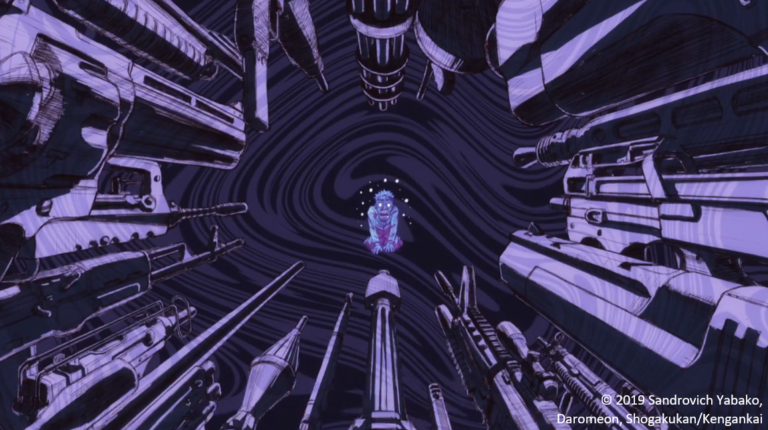
Yamashita Kazuo, a middle-aged, lowly salaryman, experienced this oppressive atmosphere when he encountered Tokita Ohma for the first time, at the very beginning of Kengan Ashura. The overpowering aura of the young and eager fighter left him breathless and barely able to speak. It was a chance meeting in a back alley in Kabukichō, but for Yamashita, this life-threatening interaction had far-reaching consequences.
The Fighter And The Salaryman
Ohma and Yamashita couldn’t be more different. Ohma is presented as a man of enormous physical prowess, with a big ego and an unwavering will. He’s focused on pursuing a single goal and is convinced the might of his fists will get him there. Yamashita, on the other hand, is a timid and submissive man with low self-esteem. But he’s also kindhearted and cares about the people in his life. Accordingly, these men represent two extremes in a ‘masculinity spectrum.’ Yet, as fate would have it, they end up pursuing a common goal. As both men fight their respective fears and try to overcome their physical and mental limits, they also learn from each other. Yamashita in particular is influenced by Ohma’s way of life and learns what it means to be ‘a man’ again.
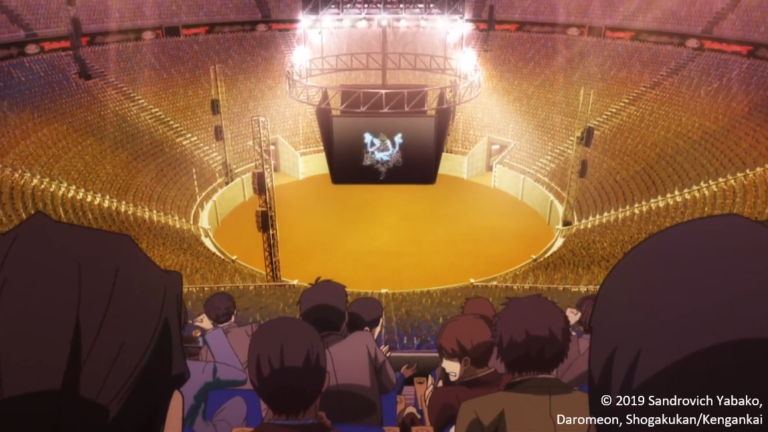
What brought this unlikely pair together was a prestigious and pompous event organized to entertain and enrich Japan’s economic elite: the Kengan Annihilation Tournament. But how did it come about that Yamashita stood side by side with financial bigwigs like Penasonic, Nentendo, or Tōyō Electric Power?
A History Of Violence
Yamashita works as a low-ranking salaryman at the Nogi Group. He is constantly being picked on by his younger superior, to whom he is constantly bowing. He has little self-confidence; his wife abandoned him; and he’s burdened by a dysfunctional relationship with his two sons. However, the situation for the mild-mannered 56-year-old changed the moment he was called into the CEO’s office. There, Nogi Hideki, the president of the Nogi Group, told him about the long history of Kengan matches, their organization, and their purpose. When you watch the anime, you shouldn’t skip the short (fictional) history lesson since this is crucial to the story. It explains how the country’s elite created order through violence. It all started in 1715, when violent disputes over vending rights between merchants filled the streets of Edo with blood. Thus, the reigning Shōgun ordered them to settle their quarrels fair and square through organized fights. So, instead of targeted assassinations, each merchant sent a champion into the ring who put his life on the line for the monetary profit of his employer.

Nogi closed with the remark that today too, companies substitute round table negotiations in shiny offices for leaky, austere underground halls to ‘negotiate’ for ever more influence, money, and power. You need not worry, though, that you might be confronted with uncomfortable imagery about coerced fighters because all the champions in the story love to fight.
War Debt
During this first conversation with Yamashita, Nogi also laid out his plan to participate in the Kengan matches with a promising fighter—Tokita Ohma. Much to Yamashita’s surprise and very much against his will, Nogi appointed him as Ohma’s manager and caretaker. Of course, educating his employee about an age-old tradition and offering him an escape from the clutches of his job wasn’t his primary aim. No, Nogi’s ambitions were directed at a higher goal. He intended to become chairman of the most influential and powerful organization in the country, the Kengan Association. To this end, he challenged the current chairman, Katahara Metsudō (also CEO of Dainippon Bank), who then declared that the issue would be settled through the Kengan Annihilation Tournament. As expected, Nogi isn’t the only one with his eyes on this prominent seat. His secretary sums it up nicely: “This tournament is essentially a stratagem battle between the companies to secure the position of chairman.” What’s more, over time, the economic elites have forgotten about the “fair and square” part of the Shōgun’s order, and they now use bribery, intimidation, and collusion to increase their chance of securing this powerful position.

One such scheme is sending more than one fighter into the fray. To do so, Nogi appointed the unwilling Yamashita as head of the newly established subsidiary, Yamashita Corporation, and made Ohma the company’s affiliated fighter. Unfortunately, no one can climb the ranks so fast without strings attached. Thus, Yamashita’s speedy promotion, together with the obligatory participation in the tournament, came with a debt of 5.1 billion Yen (currently roughly 36 million US Dollars).
By episode eight, when the actual tournament starts, we are well informed about “the secret side of the Japanese economy. It’s a world of demonic war, full of ambition and conspiracy, where people struggle for power. This is a proxy war using an extremely simple tool: violence.” And yet, the ones who are bathed in blood and who face crushed bones, slashed skins, and other unimaginable injuries or even death are not the businessmen but the fighters. And they do so willingly. That begs the question: why do these men expose themselves to such torture?
Spoken Like A Man
Luckily, the fighters don’t keep us in the dark with regard to their motivation, as they are quite eager to share. Even during the fights, there is ample time for chit-chat, where the opponents engage in analytical discussions about their fighting styles or disclose their emotional states. Ultimately, though, conversations are concluded using methods ‘befitting a man,’ as Saw Paing so passionately exclaims: “A man should speak with his fists!”
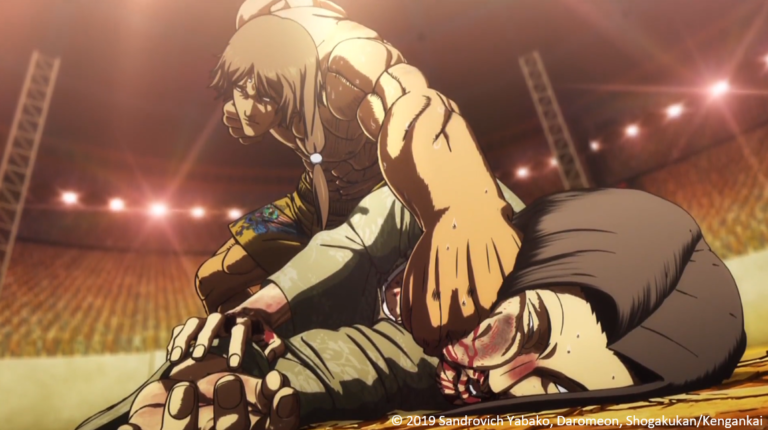
I wondered if I should get a punching bag to prepare myself for such a conversation, should the occasion ever arise. But then I realized that, in doing so, I probably totally missed the point of what these men were trying to tell me. Obviously, you can’t help noticing their passionate display of body language. But the important part is not the means but the reason why.
These fighters try to best each other using various fighting styles, including some truly horrendous methods. And they do so with a single goal in mind: I’ll show them that I’m the strongest! The good-hearted and somewhat naïve Lihito knows exactly why he’s participating in the tournament: “I just can’t accept that there are guys stronger than me. I might not get another chance. If I don’t do this, I can’t call myself a man!” Ohma, too, knows why it’s so important to be strong: “The weaker one dies. That’s obvious.”
All the fighters shared this opinion and didn’t hesitate to say so over and over again. And so, like a steady trickle of water, this message seeped into my mind until I found myself trapped in this simple Darwinian world: The strong survive, the weak die. In the Kengan universe, literally so. It’s only natural that those who lack physical superiority in such a world would long for it. Yamashita, who wished for the guts to speak up for himself, was inspired by Ohma’s single-mindedness and adamant determination: “No matter how difficult the situation was, you’ve always stood back up, and you’ve always won! I’m just a stagnating office worker, but thanks to you, I felt passion again! You reminded me that I’m a man! To me, you’re a hero, Ohma!”

After being indoctrinated about this specific type of hypermasculinity, let’s shake off our self-doubts and check out how we could attain such strength. The easiest way might be to practice one of the many martial arts styles introduced in the anime.
From Baritsu To Wrestling
The author of the manga on which the anime is based, Sandrovich Yabako, must have done extensive research about the various martial art styles. The anime shows common ones, like kickboxing or aikido. But there are others about which I’ve never heard before, like Lethwei, also known as Burmese bareknuckle boxing. Lethwei is supposed to be one of the most brutal and bloody martial arts in the world. I don’t know how these athletes train in real life, but Saw Paing’s training regimen included getting hit on the head with a hammer to withstand barehanded punches. (Not something I’d recommend for any kind of sport.)
Another sport, Baritsu, a “gentlemanly art of self-defense,” has more or less vanished from memory. The Englishman Edward William Barton-Wright created this self-defense style in 1898, which included jūjitsu and various other martial art forms. Its name is derived from Barton-Wright’s last name; hence, it’s actually called Bartitsu. Unfortunately, it was short-lived, as it was only practiced until about 1902. Not all styles come from martial arts. Adam Dudley draws on his experience as a former ice hockey player, and Karo, a commercial fisher, uses ike jime, a fish-killing technique, on his opponent.

The time I invested in each episode which showed tournament fights far exceeded its runtime. I mean, how could you not hit the pause button, start up your search engine, and dig deep into the online world of knowledge to find out about a yet unfamiliar martial art? All in all, I counted 34 fighting arts, half of which are purely fictional but nonetheless interesting. If you’re curious, I’ve listed them at the end of this text.
No Pain No Gain
Getting a hammer on the head as part of your training routine, as was the case for Saw Paing, isn’t the most pleasant experience, I imagine. But Saw isn’t the only one who underwent excruciating training drills and pushed his body beyond the threshold of pain. During the fights too, the combatants withstand repeated blows to the head, dislocated joints, and multi-fractured bones. In the best case, they just shrug off the injury and continue without batting an eye. In the worst case, it impedes their movement somewhat. Everything for the sake of proving their strength. They always fought until the very end, meaning until they dropped unconscious or dead to the sandy ground of the arena.
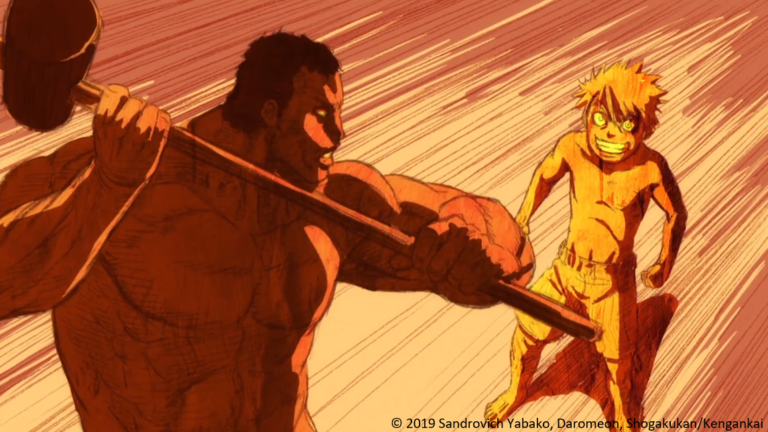
In sports, the drive to withstand injury and pain and the readiness to use (sanctioned) violence to further your own or your team’s success are connected to a certain type of sporting masculinity. (Side note: I’m only talking about male athletes right now.) The fictional Kengan universe gives us the opportunity to consume raw violence without worrying about the repercussions. In real life, the matter is a bit more complex and involves a multitude of active and passive participants. The athletes and their families, the coaches, club owners, fans, and the media, all reinforce or criticize sport-sanctioned violence. And when you throw race, social class, and economic status into the mix, it gets even more complicated. In the Kengan Annihilation Tournament, just as in real life, violence is a means to an end. What’s more, violence can be defined in a variety of ways. So, how much brutality can be allowed and what counts as excessive is an issue of debate; the boundary seems to be very blurry, though.
Violence or not, the one thing that’s undeniably connected with masculinity is the male body. And Kengan Ashura is a feast for the eyes for those of you who delight in the display of the sculpted male physique.
Muscles Galore
Besides bloody fights and unnaturally twisted body parts, your retina will be flooded with images of six-packs, bulging shoulder muscles, and the best toned quadriceps you’ll ever get to see in your life. The fighters would lend themselves perfectly to a study of the male physique, as their bodies are carved out in more detail than Roman statues. At times I wondered how highly concentrated the muscle mass under their skin must be because, similar to the inescapable gravitational pull of a black hole, the attire of these men was practically sucked onto their skin, revealing every nook and cranny of their chiseled bodies. Undressing must be a hassle under such conditions.

I watched Kengan Ashura because I wanted to see tough characters engage in ridiculously thrilling battles. And on that front, the anime does not disappoint. Excitedly, I followed Ohma, Imai, Lihito, and the others as they went beyond what’s humanly possible. Watching the fights, I winced in pain at the inflicted injuries but sighed in relief after I realized that having their fingers bent backwards is no biggie for a Kengan fighter. Since the combatants were either freakishly strong or exceptionally intelligent, there was no way to predict the outcome of the battles. After the men had been covered in blood from head to toe and the crunching sound of a bone breaking had echoed through the arena several times, I could feel that the end of the fight was near. Pushing my nose close to the screen in anticipation of the climax, I wondered which of the fighters would have to be carried out.
The only thing that dampened my enjoyment were the men’s wooden movements whenever they were not fighting. By the way, the same is true for the other characters. Too stiff to count as natural movements, it was hard to regard off-arena interactions as those of actual human beings. There’s solace, though, you’ll get used to it.
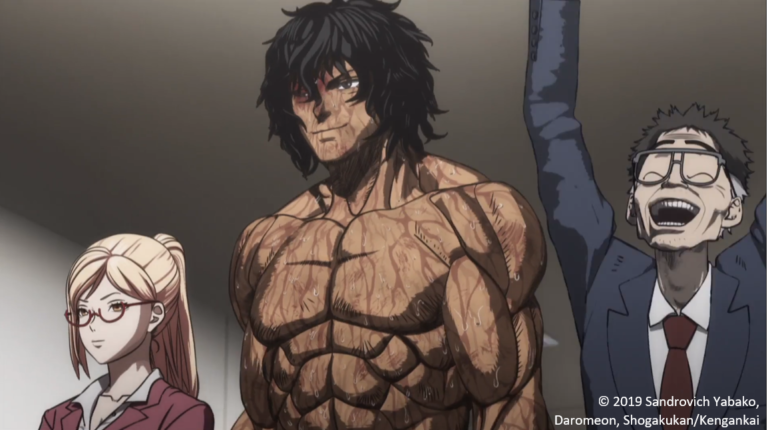
Season Two
Season one aired in 2019, and I was waiting for the second season to be released, looking forward to watching even more nail-biting fighting action. Yet, I assume that as the fights in the arena intensify, so will the underhanded battles among the executives. And with all these amazing fighters still in play, it’s no given that Ohma will win the tournament.
Kengan Ashura can be described as gripping battle royal filled with intense and captivating fights. But if you look at the series critically, you’ll find that there’s more to it. With the mix of sexism, ultraviolence, and hypermasculinity paired with the economic stakes, the anime offers plenty of material for an in-depth look. But if you ‘just’ want to watch burly guys showing off their martial arts skills during intense fighting scenes, Kengan Ashura is definitely for you. For my part, I’m eager to see what’s going to happen in season two. What can I say… I love a good fictional fight.

Fighting Styles In The Kengan Universe
Ever heard of Pankration? Did you know that Sawada is not the only one combining ballet and martial arts? Or were you aware that one of the martial arts in Kengan Ashura is used by the Japanese police to minimize injuries—quite the opposite of what’s happening in the anime. Read on to find out some of the curious details about fighters’ martial art styles.
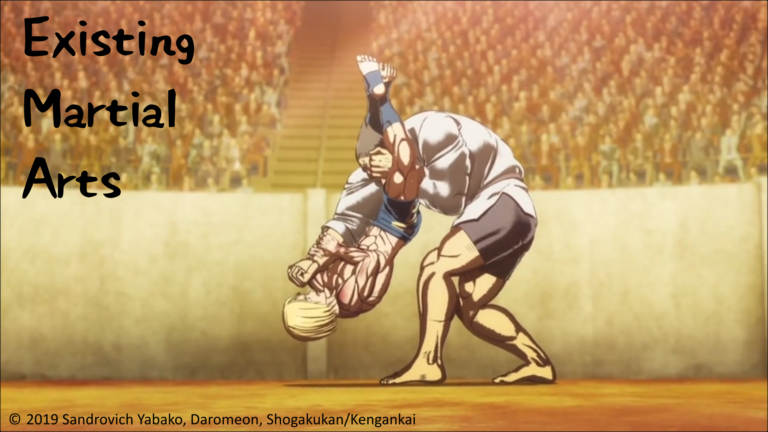
Aikidō: used by Hatsumi Sen, the Floating Cloud. Aikido was created in the 1920s. Its basic characteristic is that you don’t block but redirect the power of your opponent’s attack. While aikido is an existing martial art, the Hatsumi style practiced by Hatsumi is, most likely, purely fictional.
Baritsu (actually, Bartitsu): used by Robinson Mokichi, the Exterminating Vicar. Bartitsu was termed by its creator a “gentlemanly art of self-defense.” Between 1895 and 1898 Edward William Barton-Wright learned jūjitsu in Japan, and upon returning to Great Britain, he combined this sport with other martial arts to create Bartitsu. However, it was short-lived, as it was soon overtaken in popularity by jūjitsu and disappeared in about 1902. (Here’s a link to a short history of Bartitsu.)
Boxing: used by Wongsawat Kaolan, the Thai God of War, who is a heavyweight boxer.
Jeet Kune Dō, also Way of the Intercepting Fist: used by Himuro Ryō, the Icy Emperor. Jeet Kune Dō was developed and practiced by Bruce Lee based on several styles, namely Wing Chun, boxing, and fencing.
Jūdō: used by Meguro Masaki, the Crying Man. Meguro’s body turns pain into pleasure, but he also rejoices in hurting and killing others. In anticipation of being able to do so, he cries joyful tears of blood, hence his nickname. In addition to his psychopathic inclinations, his lineage as the son of a jūdō teacher provides him with the means to fight his opponent. His excessively long tongue doesn’t seem to serve a specific purpose, though.
Jūjitsu: used by Imai Cosmo the King of Stranglers. Jūjitsu is a Japanese martial art that uses strikes, throws, and holds. Today, there are a variety of jūjitsu styles. While Imai’s style isn’t further specified, Kiryū Setsuna, the Beautiful Beast, who also practices jūjitsu, uses the fictional Koei style.
Karate: used by Wakatsuki Takeshi, the Wild Tiger. Karate has its origins in Okinawan karate (Okinawa-te) but was influenced by Chinese martial arts. Karate (in its merged form) was introduced to mainland Japan at the beginning of the 20th century.
Kickboxing: used by Karaev Ivan. He has no nickname, but his kick is so powerful that it’s called the Reaper’s Sickle. I tried to look up the history of kickboxing and ended up confused. As far as I could gather, it originates from Japanese full-contact karate, or a blend of karate and Muay Thai but was also influenced by other styles. Depending on the source, it’s either a very old or a rather new sport (since the 1960s, when the term kickboxing was introduced).
Lethwei: used by Yoroizuka Saw Paing, the Howling Fighting Spirit. Myanmar Lethwei, also known as Burmese bareknuckle boxing, is supposed to be one of the most brutal martial arts. It’s an old style, dating back to the 12th century. More or less everything goes in this sport: fists, elbows, kicks, and headbutts, hence its other name, the “art of nine limbs.”
Lingshu Chin Na: used by Hanafusa Hajime. He goes by several names: the Murder Physician, Doctor Death, or the Dissector. The martial art Lingshu Chin Na seems fictional, but its components do exist, albeit as separate entities. So, Hanafusa actually uses a combination of three techniques to kill his opponent. The Chinese martial art Chin Na or Quinna is not a separate style but a technique to control or immobilize your opponent by locking their joints. Since Hanafusa lacks physical strength, he uses another method to incapacitate Bandō, the other fighter. For this, he draws on his knowledge about acupuncture points which he must have gathered from the Lingshu, the second of the two texts in the Huangdi Neijing. But since Bandō can’t be killed with physical attacks, Hanafusa resorts to poisoning.
MMA, mixed martial arts: used by Ōhkubo Naoya, the King of Combat, or Rocky of Osaka. As the name mixed martial arts suggests, MMA is a full-contact combat sport where fighters can use various disciplines and their techniques, including strikes, kicks, and grappling. Contrary to the Kengan matches, there are weight classes and rules that the fighters have to follow, like wearing gloves. By the way, the ancient Greek Olympic discipline Pankration is supposed to be a precursor to MMA.
MMA, military martial arts: used by Muteba Gizenga, the Genozider is described as a legendary mercenary. He uses military martial arts as his preferred fighting style. This is the martial arts training soldiers receive to prepare them for hand-to-hand combat. There are a variety of styles that can be taught, like Brazilian Jūjitsu, jūdō, or country-specific forms, like the Marine Corps Martial Arts Program (MCMAP) or Systema, a style taught in the Russian military. Gizenga is also a womanizer, and instead of concentrating on his upcoming fight, he leaves behind a carpet of naked, heavily panting women on his way to the arena. (Much can be said about this, but attracting women like a flower attracts bees is no martial art, so I’ll leave it at that.)
Pankration: This isn’t practiced by a fighter but is mentioned in connection with sumō: “Sumō was originally a mixed martial art in ancient times like Pankration.” The name Pankration is a combination of the words pan (all) and kratos or kratō (mastery)*. Its mythological origin story dates back to Herakles and Theseus. As a sport, it’s said to have first appeared at the Olympic Games in 648 BC, and it is most similar to modern MMA, using a combination of striking and kicking, wrestling, and grappling. Nowadays, Pankration is practiced again. (*AMO Pankration youtube channel)
Sumō: used by Kiohzan Takeru, the Brawler of the Sumō Ring. Sumō is Japan’s national sport besides baseball.
Taiho Jutsu: used by Akoya Seishū, the Executioner. Akoya works at the metropolitan police department and has a strong but misguided sense of justice. He uses Taiho Jutsu, a fusion of martial arts styles used by Japanese police forces and other public officers in similar professions. Its function is to arrest and restrain criminals while minimizing their injuries and maximizing the policemen’s safety. However, Akoya’s unyielding conviction to purge the world of evil incites him to kill those who resist his judgment and don’t surrender willingly.
Wrestling: used by Sekibayashi Jun, Hell’s Angel. Sekibayashi prides himself on being a good actor, something wrestlers seemingly need to put on a good show for the viewers.

Copycat: used by Chiba Takayuki, the Faceless Man. Chiba can impersonate any martial arts fighter he sees, up to the point that he looks exactly like them. Additionally, he can switch between people and styles within seconds, which even surpasses Ethan Hunt’s capabilities. The downside: he can use each style only as far as his own physical abilities permit.
Kaiwan style: used by Kuroki Gensai, the Devil Lance. Kuroki practices the Kaiwan-style of assassination martial arts, incorporating Okinawan karate and other undefined Chinese styles. Kaiwan actually means remarkable or amazing ability. Similar to Lethwei, the training follows the principle that injury hardens your body. Thus, using a makiwara striking post to repeatedly injure and break his fingers, Kuroki made them hard enough to pierce metal. While the Kaiwan style is purely fictional, the makiwara board does exist and has its origins in Okinawan martial arts, just as karate itself. I doubt, though, that it ought to be used for self-injury.
Kujin-style: used by Kaneda Suekichi, the Giant Killer. Not much is explained about this fictional martial art apart from the information that it was created during the Sengoku (Warring States) period in the 15th and 16th centuries. It incorporates locking and throwing techniques, but the most important technique is Foresight. This enables Kaneda to predict his opponent’s attack pattern, similar to Shiratori in Ryman’s Club.
Niko Style: used by Tokita Ohma, the Ashura. The Niko style is an amalgamation of various martial arts techniques, expressed in four kata. Each of these might be based on real styles, like karate, boxing, jūjitsu, jūdō and aikido. Check out these links to read more about the Niko Style: What is the Niko style; Martial art closest to the Niko Style.)
Raishin: used by Mikazuchi Rei, the Lightening God. Raishin is an assassination art, said to have a 1,200-year history. Moving at the speed of lightening is not enough, though, to practice this style. To be able to truly utilize it, one has to be lightening… if we are to believe Mikazuki’s teacher. Still, Mikazuki’s true power lies not in his fast movements but in his immortal love for his female employer, Kurayoshi Rino.
Razor’s Edge: used by Lihito (real name: Nakata Ichirō), the Superhuman. Lihito has incredible grip strength and razor-like fingertips. He ‘cuts’ his opponents with his fingers. Good for rock climbing and cooking; maybe not so good if you want to hold a woman tenderly in your arms… .
Tenroken: used by Nikaido Ren, the Watchman. The fighter from Taiwan practices the lost Japanese-style Chinese martial art Heavenly Wolf Fist, or Tenroken. Since it’s a lost style and I wasn’t able to find any information on it. Yet, if you are curious about it, the anime gives detailed information about one of its techniques, used by the (last?) remaining practitioner. …maybe there’s still hope for its revival. The commentator, Jerry, also seems to be quite knowledgeable about this ‘lost’ martial art.
‘Weaponized’ Xing Yi Quan: used by Jerry Tyson, the Rocket Man. He originally learned Xing Yi Quan, or Xingyiquan. This is a Chinese internal martial art, meaning that it focuses on movements derived from the five elements (fire, water, wood, air, and metal), which strengthen the inner body (the organs). Twelve more styles are based on the movements of animals. Jerry then adapted this style to base his movements on weapons, which he deemed more effective for fighting.

Ballet: used by Sawada Keizaburō, the Bird of Darkness. Sawada combines the flexibility of a ballet dancer with strong kicks. Anyone who’s ever practiced martial arts and tried to master kicks to the chest or head knows that flexibility is very important. But there are also real-life men who profit from combining these two disciplines, like MMA fighter David Branch or ballet dancer George Birkadze. I’m sure you all know Jean-Claude Van Damme; he too practiced ballet in addition to karate.
Ice hockey: used by Adam Dudley, the Emperor. Ice hockey is described as a sport where fights among the players are tolerated. Dudley was particularly good at it and was the last one standing amidst a field of bloodied bodies. While the real-world rules wouldn’t have permitted Dudley to batter everyone unconscious, there is truth in this explanation. Technically, fist fights are not allowed in ice hockey and are penalized. Yet, they are an inherent part of this sport—in the NHL (National Hockey League), in any case. Clubs, fans, the media, and the players each have their own reasons to partake in and reinforce this behavior. But since it can cause injuries (and death) this practice comes at detrimental costs. For a deeper dive check out this research paper: NHL heavyweights: Narratives of violence and masculinity in ice hockey.
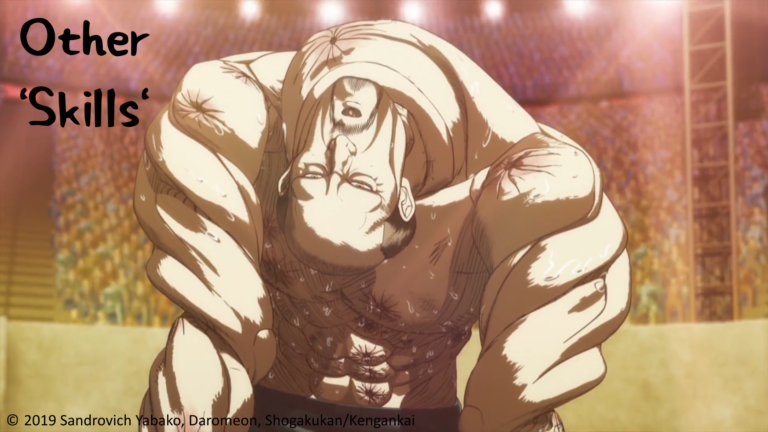
Assassin’s Breed: Kure Raian, the Taboo Descendant. Decades-long selective breeding of the finest warrior seeds gave birth to “a race specialized for battle.” Additionally, Raian uses a technique called Removal. With this, he—as the name suggests—removes any constraints placed on the body by the brain and is able to go all out in his fights.
Delinquency and innocence: Nezu Masami, the Man from the Land of Dreams. Nezu is the most interesting character from a parody perspective because he combines delinquency with childlike innocence. He was the leader of a motorcycle gang before starting to work at Destiny Land as the mascot, Mockey. In the Kengan universe, these biker gangs are called bōsōshūdan. The real-life equivalent is the bōsōzoku, a youth subculture that emerged in the 1970s and 1980s and that is associated with motorcycles, loud engines, riots, petty crimes, illegal street races, and street parades (hence the title of Nezu’s intro music before the match: The Eccentric Parade). On the other hand, Nezu now works as Mockey in Destiny Land. (I assume you know who this is referring to.) His childlike and naive dedication to the park is in stark contrast to his gang origins. I wonder why Sandrovich chose to combine these opposing traits within one character.
Gurkha soldier, Kohno Haruo, the Destroyer. Originally, Gurkhas were soldiers in the kingdom of Nepal. After losing the Anglo-Nepalese war (1814–1816), these soldiers and mercenaries were recruited into the British army. Today, they fight in various war zones all over the world. They are said to be exceptionally fierce fighters.
Ike jime: used by Karo Yoshinari, the Giant of the Sea of Japan. Karo is a commercial fisher and applies ike jime to his opponent. This is a method to kill and afterwards bleed a fish. Using ike jime will guarantee the high quality of the meat. To do so, a spike is pushed into the hindbrain, killing the fish immediately.
Inaba style or hairy strength: used by Inaba Ryō, the Black Phantom. Inaba belongs to an assassin’s clan, where impeccable haircare is of primary importance because the hair is used as a weapon. Not quite as strong as the anime makes us believe, but still, a single hair is capable of holding a weight of 100 g or 3.5 oz (in the anime: 150g or 5.3 oz). Thus, theoretically speaking, a single hair could carry a medium-sized tomato. Inaba’s hair has been infused with a wonderous ointment since his childhood, making it as strong as steel wire, but unfortunately, no such haircare product exists in real life. And yet, we might not need it because human hair seems to be one of the stronger ones in the animal kingdom. Curious? Here’s what some researchers found out: On the strength of hair across species and a short interview with one of the authors.
Joint hypermobility: Bandō Yōhei, the Bloody Tusk. Joint hypermobility is a physical trait where your joints are extremely flexible. Now, before you envy hypermobile people’s ability to effortlessly fall into a split, remember that it can also come with pain and other symptoms, like fatigue, joint injuries, and bladder and bowel issues.
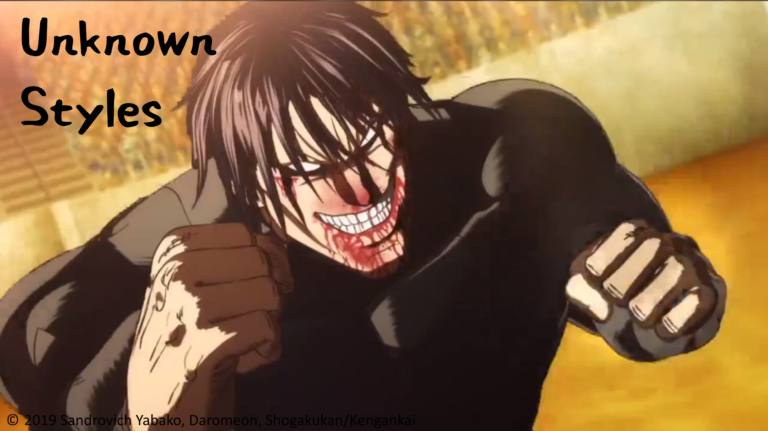
The Fang: Kanoh Agito, or Fang of Metsudō; Fang is such a powerful fighter, the reigning emperor of the Kengan matches, that he doesn’t need a name for his fighting style… he is his fighting style. Fighting him ‘defangs’ his opponents, making them unable to ever fight again. Personally, I’d call it Titan or Kyojin Style, because when he goes all out, he’s almost the spitting image of Eren Yaeger from Attack on Titan.
The Monster: Julius Reinhold, the Monster. So far, no information has been given about his fighting style. But since he can withstand powerful kicks and crushes bones with a single hand like scrunching up a piece of paper, this much is obvious: he is super-strong.
Links:
- Original post published on sportsbaka.substack.com
Subscribe to never miss a deep dive into the exciting world of sports anime, manga, and manhwa!

